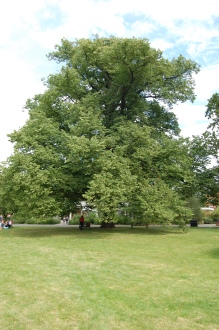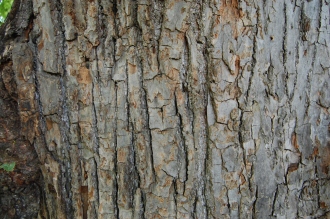Position: Full sun to partial shade
Flowering period: Early summer
Soil: Well drained
Eventual Height: 40m
Eventual Spread: 15m
Hardiness: 3a, 3b, 4a, 4b, 5a, 5b, 6a, 6b, 7a, 7b, 8a, 8b, 9a
Family: Malvaceae
Tilia x europaea is a large deciduous tree with a spreading habit. Its dark green leaves are are asymmetrical cordate with entire margins, up to 15cm long and 12cm broad. The underside of the leaf is hairy with tufts of denser hairs along the leaf vein axis. Its trunk may achieve a diameter of up to 80cm. Its bark is fine grained and its inner bark is quite stringy. Its fragrant hermaphrodite flowers are produced in clusters of up to 10, with a leafy yellow green subtending bract. The fruit is a dry nut-like drupe 8mm in diameter and is downy and faintly ribbed in appearance.
Tilia x europaea, commonly known as the Common Lime or the Linden, is a naturally occurring hybrid between Tilia cordata and the Tilia platyphyllos. Tilia x europaea is synonymous with Tilia x vulgaris. It naturally occurs in the wild in Europe at various locations. It is also listed as Britain’s tallest broad leafed tree reaching a height of up to 40m.
The etymological root of the binomial name Tilia is the old Latin name for the Lime tree. Europaea is derived from the Latin meaning of or from Europe.

Tilia x europaea (28/07/2012, Kew Gardens, London)
The landscape architect may find Tilia x europaea useful as a large parkland tree. Although often used as an avenue tree it is not the best suited Lime for this purpose as it will require a lot a pruning due to its eventual size, it produces sprouts from it’s base and due to the large populations of aphids this tree harbors, honeydew below the canopy can be a problem. It can tolerate strong winds but not maritime conditions.
Ecologically, Tilia x europaea provides a valuable source of food for aphids who feed on it’s leaves. The sweet smelling flowers of this tree attract bee’s which enjoy the tree’s abundant nectar. This tree also is great at attracting moths such as the green caterpillar or lime hawk moth which feed on the tree’s leaves.
Tilia x europaea is tolerant of most soils from sandy to clay soils, as long as it is well drained soil. It can also grow in nutritionally poor soils. It requires a soil pH of acid to alkali.

Tilia x europaea Bark (28/07/2012, Kew Gardens, London)
The Royal Horticultural Society has given Tilia x europaea ‘Wratislaviensis’ their prestigious Award of Garden Merit in 1993.
Tilia x europaea requires little maintenance and can tolerate heavy pruning when necessary. This tree is suitable for pollarding. If the specimen is being pollarded it should be carried out every year or every other year and should be carried out in late winter or early spring.






Could you give me a glimpse of Tilia Europaea’s history, as used in the landscape architecture? We found some very short, but probably 114 years old ones, from an island in eastern Finland. We are planning a performance with them, and would like to know their broader background in culture. What is incredible with these individuals, are, that, they are short, but their body is lumpy. That is strange, because the relatives of the one’s, small-leaved limes, are straight in the same area. Therefore it seems, that the effect comes from the human influence. So when they were first used, and for what ideals in landscape architecture?
Jaakko, these couple of liks may give you a better idea if the history of this tree: http://www.lincolnshireherbal.com/Herb-Profiles/tilia.html http://www.pfaf.org/user/Plant.aspx?LatinName=Tilia+x+europaea , I hope they are of some help. Good luck with your performance.
Is it good for linden tea
Cecelia, I am afraid I am not qualified to answer that question.